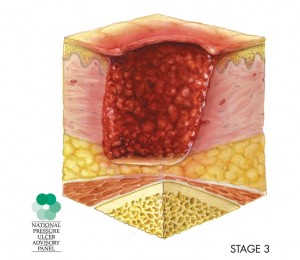Stage 3 Pressure Sore
The staging of pressure sores provides a standardize means to characterize the wound. Guidelines for staging pressure ulcers have been set forth by the National Pressure Ulcer Advisory Panel and are the consensus for staging. Pressure sore stages range from Stage 1, a mild skin redness, to Stage 4 where severe tissue damage is present.
Stage III Characteristics include:
- full thickness skin loss involving damage or necrosis of the subcutaneous tissue
- skin breakage does not go into the muscle or bone
- slough (dead tissue) may be present but does not go into the muscle or bone
- may include undermining, meaning that there is overhanging skin edges at the margin of the wound, so the pressure ulcer is larger in area at its base than at the skin surface.
- may include tunneling, meaning that a tunnel has formed with the wound into other tissues
- changes to the pressure area can develop
A pressure sore at the Stage 3 level has progressed to a point where treatment and healing may be difficult and will be slow. Wounds in this stage often need specialized wound care with cleaning and debriding agents, and may even need surgery. Common treatment of a stage 3 pressure sore includes:
- an overall assessment of the patient’s health, taking into account their ability to reposition themselves, their mental awareness, and their nutritional needs
- frequent position changes and the use of pressure reliving devices
- cleansing of the wound with water or saline
- debridement of the wound (removal of the devitalized tissue from a wound)
- application of topical dressings
More Information:
